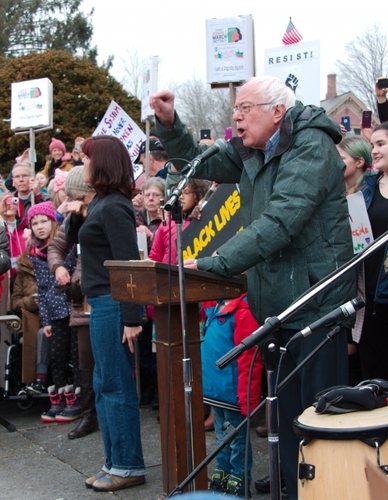BRATTLEBORO — In a town where he received only 15 percent of the vote, it was almost a certainty that the inauguration of President Donald J. Trump would be greeted with protests.
And, over three days, the people of the Brattleboro area held quiet and thoughtful events to express their resolve to oppose the policies of the incoming administration.
Light in the darkness
The theater community in Brattleboro expressed their opposition to Trump on Jan. 19 by participating in a nationwide vigil called The Ghostlight Project.
Named for the theater tradition of leaving one small light lit on stage after a performance, about 25 people gathered in the alleyway to the Hooker-Dunham Theater on Main Street, and another 100 people gathered at the New England Youth Theatre on Flat Street to dedicate a light that would - in the words of Hooker-Dunham Theater manager Jon Mack - “remain lit for the next four years or until it is no longer necessary.”
Josh Moyse, leader of Shoot The Moon, the Hooker-Dunham's resident theater company, said the light they were dedicating was meant “to represent our commitment to safeguard our values” and to “symbolize safe harbor for our values and for any among us who find ourselves targeted because of race, class, religion, country of origin, immigration status, disability, sexual identity, or dissident actions in the coming years.”
At 5:30 p.m., the agreed-to time that theaters in each time zone would turn on their lights, Moyse asked the people attending to turn on their lights in unison with the lamp serving as the ghostlight. Cellphones and penlights came on at the count of three in an effort, in Moyse's words “to symbolize hope and the belief that through our actions, change is possible.”
Speaking for the planet
In the last light of a gray Jan. 20 afternoon, about 50 people gathered at the Wells Fountain at the intersection of Main and Linden streets and Putney Road for what organizers called “A Vigil for the Earth.”
Fred Taylor of the Manitou Project in Williamsville helped organize the event, and was emphatic about the vigil not being political: “We're trying to emphasize a positive statement of our moral, ethical, and spiritual values.”
Some of Taylor's students from his environmental studies class at Keene State College were at the vigil. They had already participated in a march through downtown Keene, N.H., earlier in the afternoon to coincide with Trump's inauguration.
Children tagged along with their parents, carrying signs they made for the vigil. But even though Taylor wanted to see the vigil focus on protecting and preserving the environment, some of the signs alluded to the new administration.
“This is not normal,” read the sign carried by one child.
And not everyone agreed with what they were doing.
“I don't give a f--k about your protest!” yelled one woman as she drove past.
Many voices joining as one
The Women's March on Washington on Jan. 21, which drew more than 500,000 people to the Capitol, spawned more than 600 “sister” marches all over the world, including an event in Montpelier that saw 18,000 people jam the lawn of the Statehouse and the 175,000 people that turned out in Boston in opposition to Trump.
In Brattleboro, retired teacher Maggie Cassidy noticed that no formal event was scheduled for Jan. 21 and said she wanted to do something for the people who weren't able to go to Montpelier, Boston, or Washington. So she organized a noontime vigil for Pliny Park in Brattleboro, and more than 250 people showed up.
“I really didn't think we'd see this many people, because there were so many others headed to the other marches,” Cassidy said. “This was beautiful!”
The crowd at Pliny Park ranged from young children attending their first political event to older people who have been politically active for decades and knew all the words to the songs that Cassidy was leading the crowd in singing.
As was the case the day before, there was only some drive-by dissent. “Get a life!” one man yelled from his car.
And, unlike the “Black Lives Matter” vigil at Pliny Park in July that attracted a similarly-sized crowd, there was no police presence at the Jan. 21 vigil.
